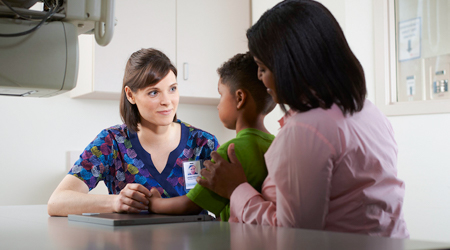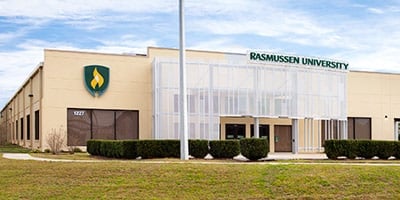In as few as 24 months, you could be ready to work as a radiologic technologist.1 With an Associate’s degree in Radiologic Technology, you'll gain proficiency in diagnostic imaging, physiology and radiation safety, and learn to confidently convey assured leadership with patients. Through career-focused curriculum and hands-on opportunities in this Radiologic Technology Associate's degree program, you'll be able to utilize standard X-ray, mobile X-ray and fluoroscopic technologies, along with patient care techniques. With practical, highly trained skills, you'll feel prepared and market-ready to enter the radiology field. The Radiology Technology Associate’s degree is available with $149 self-directed assessments, which allow you to prove that you already have the knowledge for a particular course and don't need to take it.
Take me to:
What Will I Be Prepared to Do When I’m Done?
Strive for Industry Certification
Our Radiology Technology Associate's degree courses prepare you for the American Registry of Radiologic Technologists (ARRT) certification exam to earn your certification and registration.2
Advance Your Education
Credits earned in this on-campus and online Radiologic Technology program transfer smoothly into our Health and Wellness Bachelor’s degree for even more in-demand knowledge and skills within the healthcare industry.
Pursue Potential Job Growth
According to the Bureau of Labor Statistics (BLS), the projected job growth potential between 2020 and 2030 for Radiologic Technologists and Technicians is 9%.3 A Radiologic Technology degree from Rasmussen University can help set you up for success in this growing field.
Take the Next Step—Talk to Us!
What Skills Will I Gain?
Accurate Anatomical Imaging
Leverage foundational knowledge in anatomy and physiology to adapt exams to each patient for precise images.
Radiographic Equipment Operation
Use different types of radiographic equipment and evaluate technical factors to perform diagnostic imaging exams.
Adherence to Safety Standards
Follow radiation safety practices for patients and personnel.
Patient Care and Positioning
Accurately assess patient sensitivity and condition to modify procedures as needed while keeping patients informed along the way.

What Types of Classes Will I Take?
-
Radiology Physics
- RTE 1100
- On Campus and Online
- 5 Credits
Studies the process in which the X-ray circuit creates electrons and the interactions that occur inside and outside the X-ray tube.
-
Radiographic Positioning and Anatomy
- RTE 2300
- Clinical, On Campus and Online
- 5 Credits
Introduces radiography positioning and associated anatomy of the chest, bony thorax, upper extremities and abdomen.
-
Radiologic Technology Practicum I
- RTE 2600
- On Campus
- 10 Credits
Provides students with a clinical experience that includes a solid introduction to radiographic imaging in various clinical settings.
23 Courses to Complete
108 Credit Hours
Estimate Your Tuition
Rasmussen University is committed to making education more affordable for all students. Our tuition estimating tool can help you visualize the cost of your degree and see what savings opportunities are available to help you achieve it.
Rasmussen University believes in helping you make your education as affordable as possible.
Our interactive tuition estimator is designed to help you discover how much you could save on a degree from Rasmussen University.
Simply enter your ZIP code, select the program and credential you're interested in, and click “next”.
Right away, you can see the total estimated cost of your selected degree.
As you engage with the tool, you may see this number start to go down.
You also have the option to see how attending full-time or part-time could impact your tuition—and what your tuition estimate looks like, broken down by quarter.
The tuition estimator walks you through a number of ways you could reduce your overall tuition.
Click the tabs or the “back” and “next” buttons to move through the tool.
Within each tab, answer the question shown as accurately as you can, by interacting with the slider, select menu or radio buttons shown.
You might not feel totally confident in all of your answers. That's okay. This tool is just generating an estimate of how much your degree might cost.
The last tab of the tool shows you your results, including how much you could potentially save on your Rasmussen degree.
Remember, the numbers shown here are just estimates, and the true cost of your degree will vary.
Talk with an admissions advisor for more information about how to make your Rasmussen degree as affordable as possible.
What Should I Know Before I Enroll?
Entrance Requirements
Entrance requirements for the School of Health Sciences vary by program. To learn more and receive help planning your healthcare education path, contact an admissions advisor who will speak to you about immunizations, background checks and entrance exam options.
Transfer Student
We believe in giving credit where it’s due. You can get an estimate of your transfer credits without an official transcript in one business day (on average). Talk to an admissions advisor today, or explore our Transfer Policy page for our seamless credit policies designed to maximize credits, potentially save money and expedite graduation.
Help Paying for College
Higher education should be a manageable investment. Talk to an admissions advisor and learn how these programs can make it more affordable with self-directed assessments, credit for prior learning, loans and grants, scholarship opportunities, corporate grants and military discounts for those who qualify.
Where Can I Find a Radiologic Technology Program Near Me?
At Rasmussen University, we want our courses to be available on your schedule, not the other way around. Select programs are available for enrollment through a specific campus and nationally online, but students complete the courses online and can utilize online and on-campus support and resources.
The degree type can vary based on the state. This is an Associate of Science (AS) degree in FL, and an Associate of Applied Science (AAS) degree in MN.
See below to find out where you can find a Radiologic Technology program near you.


